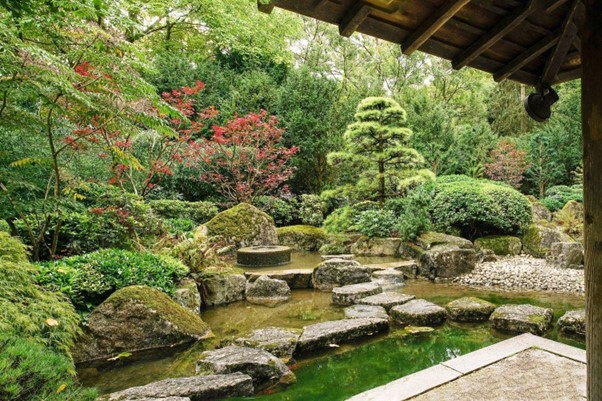The Japanese garden reflects the intimate principles of nature, depicting the universe with carefully designed elements that create visual harmony. An intriguing aspect of these gardens is the absence of flowers, instead favouring a strict and austere style. It’s important to note that Japanese philosophy admires flowers as a unique expression of life, avoiding the sole purpose of decoration. Derived from Zen philosophy, the principles of a Japanese garden embody the subtlety specific to traditional Japanese culture. These principles include the following elements.
Zen Garden Ideas
What do mini Zen gardens do? It gives calm, peace and harmony, but the sensations may change depending on the garden you choose. Here are some traditional and modern interpretations of the Zen garden:
- Kanso represents simplicity. It emphasizes natural expression in landscaping, deriving clarity and purity from the garden landscape.
- Fukinsei embodies asymmetry, a technique used in Zen aesthetics to maintain balance in composition. Imperfections are intentionally embraced as part of existence.
- Shibumi values beauty derived from elegant simplicity. In landscaping, it promotes a non-intrusive and subtle concept without relying on visual explanations.
- Shizen signifies the natural, devoid of artificiality and forced elements. It follows a distinct target in creation and rejects the naïve and casual. According to Zen Philosophy, it is characterized by apparent simplicity and the idea of spontaneity in landscaping.
- Yugen symbolizes allusion, where the invisible holds greater importance than the obvious. Landscapes are skillfully concealed, offering surprises through the play of areas, shadow reflections on lakes, and textures hinting at elements.
- Datsuzoku embodies surprise, aiming to evoke astonishment and break conventions. This principle honors the emotional response of the beholder and represents elegant creativity.
- Seijaku embodies tranquility. It seeks an active silence, an energized, alert, and perceptive calmness. The garden’s purpose is to convey the energy of active silence.
What are the principles of Zen gardens?
#1 Austerity
The concept of koko emphasizes the significance of absence and omission, highlighting the impact of negation on space. It is characterized by simplicity and clarity, without unnecessary embellishments. Only essential elements should be included, creating room for emptiness and its endless potential for habitation. By limiting decorations, boundless possibilities can emerge.
#2 Choose the right plants
Zen gardens typically use a limited number of plants, but you can customize this aspect to suit your personal style and preferences. The plants used in Zen gardens are usually low and creeping, complementing the hardscaping without overpowering it. If you need to find a suitable species or you saw it and don’t know what this plant is, use the Lily app. With the identify plants app, you can find out not only the plant variety but also all its details: shape, care, growth duration, etc. If you have plant identification on hand, you can even add flowers to your Zen garden, but you need to be careful so that the flowers have calm, harmonious shades. As long as you have the plant app, you can experiment with the shades and shapes of your lawns. Most often searched for in this app for iPhone for Zen gardens are bonsai, topiaries, dwarf conifers, Japanese maples, azaleas, and bamboo.
#3 Subtlety
Not disclosing everything in a single impression is crucial. Insinuation, imagination, and seduction of forms that withhold complete revelation possess a magnetic power over the viewer. To confront the vices of excess once more, subtlety sharpens perception and enables the attainment of elevated states of consciousness. By avoiding the burden of excessive information, subtlety allows for a more acute awareness.
#4 Stillness
The Seijaku principle applies meditation’s properties to design by fostering calmness, concentration, and inspiring alertness and creativity. The design draws inspiration from meditation as it becomes a reflection of mental states in physical spaces.
#5 Creating a tranquil atmosphere
Creating a tranquil atmosphere is the essence of Zen Garden design. To achieve this, Zen gardens typically have few plants. However, carefully selecting plants with unique textures and colors can enhance the aesthetic. For example, strategically placing a pop of color, like an Acer tree with its various varieties and sizes, can add a delightful touch with its fiery red autumn tones. Similar considerations apply to spring-blooming shrubs.
#6 Naturalness
Shizen embodies naturalness in design, striving for a harmonious blend of nature and distinctiveness. Architectural adaptation to the environment reflects both artistic intention and synchronous incorporation of natural light, vegetation, wind, and topography. This rhythmic distillation of design, characterized by a deliberate trace or subtle symbolic presence, epitomizes the highest art form.
#7 Simplicity
Simplicity, exemplified by the concept of kanso, suggests that one should not express beauty and usefulness excessively. There is no need to gloat or decorate exorbitantly. Thus, achieving a sense of freshness, order, and cleanliness.
Conclusion
The Zen gardens bring us closer to Japanese culture, offering a creative spark and a space for self-reflection. They alleviate stress, improve our focus, and enhance our sense of well-being. So, put any doubts aside and make room for your passion. Transform your side project by starting

